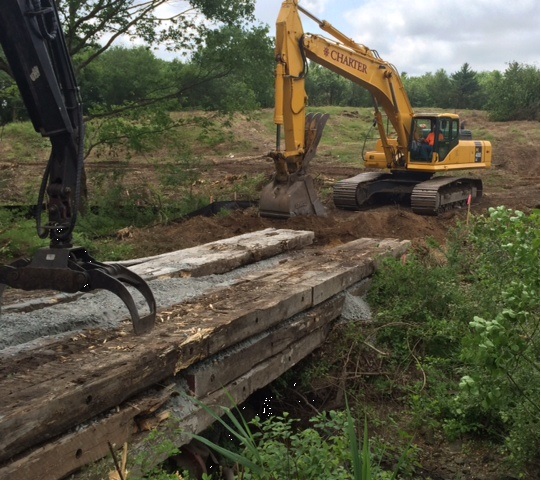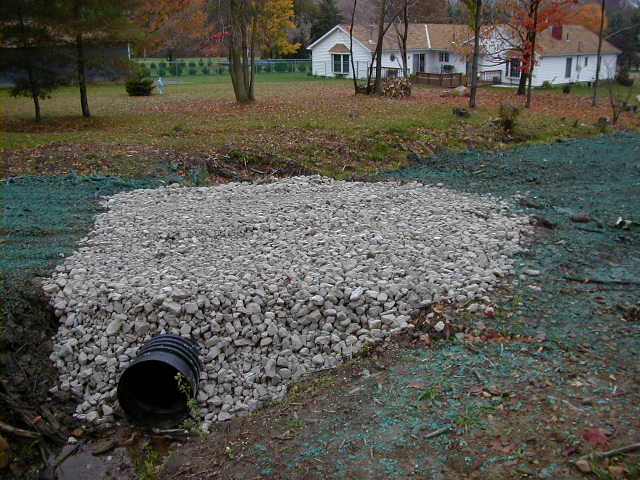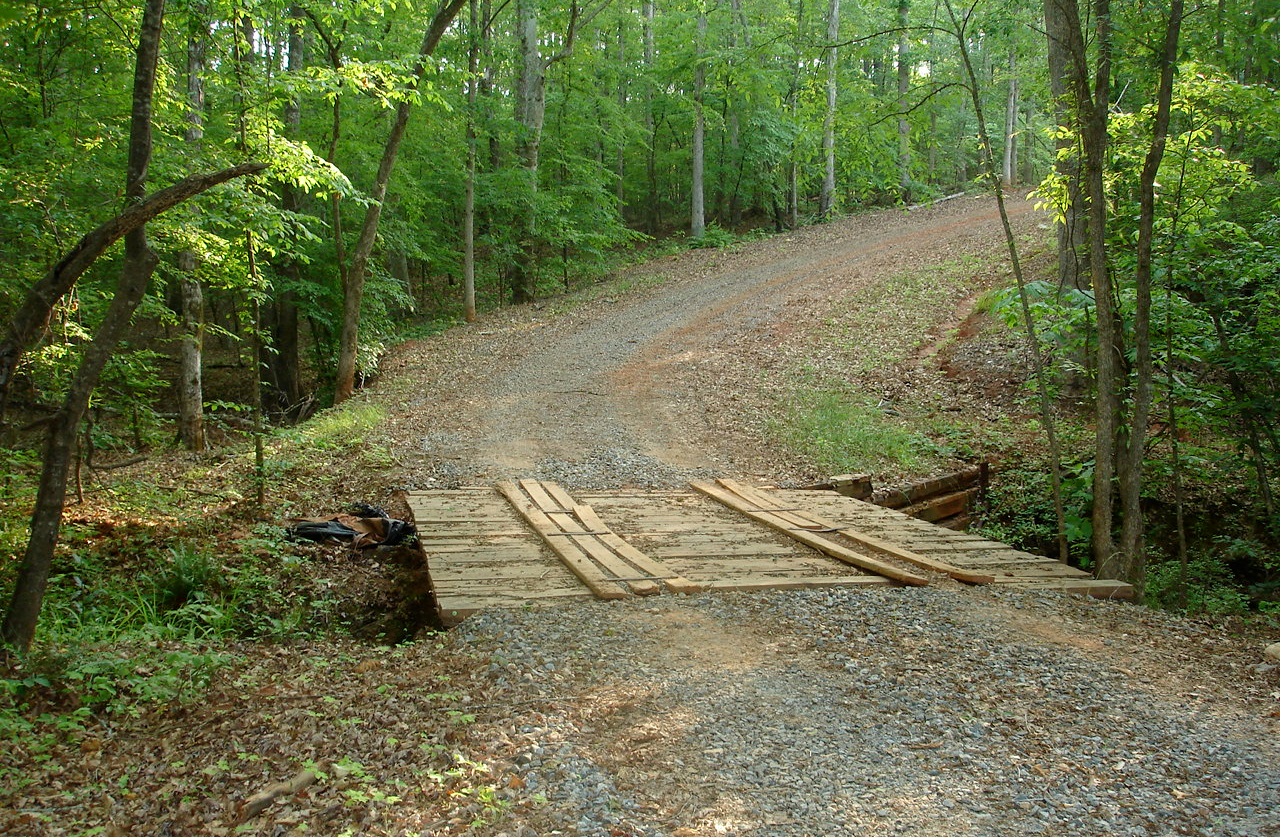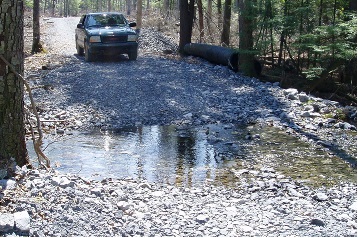Stream Crossing, Temporary

Definition
A bridge, ford or temporary structure installed across a stream or watercourse for short-term use by construction vehicles or heavy equipment. To provide a means for construction vehicles to cross streams or watercourses without moving sediment into streams, damaging the streambed or channel, or causing flooding.
Where Practice Applies
Where heavy equipment must be moved from one side of a stream channel to another, or where light-duty construction vehicles must cross the stream channel frequently for a short period of time.
Planning Considerations
- Contact the local Conservation Commission regarding any stream crossing or other work conducted in a wetland resource area. The Wetlands Protection Act requires that for any stream crossing or other work conducted in a wetland resource area, or within 100 feet of a wetland resource area, the proponent file a "Request for Determination of Applicability " or a "Notice of Intent " with the Conservation Commission.
- Careful planning can minimize the need for stream crossings. Try to avoid crossing streams, whenever possible, complete the development separately on each side and leave a natural buffer zone along the stream.
- Temporary stream crossings are necessary to prevent damage to stream banks and stream channels by construction vehicles crossing the stream. This reduces the sediment and other pollutants continually being tracked into the stream by vehicles. These are temporary crossings that represent channel constrictions which may cause obstruction to flow or erosion during periods of high flow. They should be in service for the shortest practical period of time and should be removed as soon as their function is complete.
- Select locations for stream crossings where erosion potential is low. Evaluate stream channel conditions, overflow areas, and surface runoff control at the site before choosing the type of crossing. When practical, locate and design temporary stream crossings to serve as permanent crossings to keep stream disturbance to a minimum.
- Plan stream crossings in advance of need, and when possible, construct them during dry periods to minimize stream disturbance and reduce cost. Ensure that all necessary materials and equipment are onsite before any work is begun. Complete construction in an expedient manner and stabilize the area immediately.
- When construction requires dewatering of the site, construct a bypass channel before undertaking other work. If stream velocity exceeds that allowed for the in place soil material, stabilize the bypass channel with riprap or other suitable material. After the bypass is completed and stable, the stream may be diverted.
- Unlike permanent stream crossings, temporary stream crossings may be allowed to overtop during peak storm periods. The structure and approaches should, however, remain stable. Keep any fill needed in floodplains to a minimum to prevent upstream flooding and reduce erosion potential. Use riprap to protect locations subject to erosion from overflow.
- Stream crossings are of three types: bridges, culverts, and fords. In selecting a stream crossing practice consider: frequency and kind of use, stream channel conditions; overflow areas; potential flood damage; and surface runoff control.

Temporary Culvert Crossing
Culverts
Culverts are the most common stream crossings. In many cases, they are the least costly to install, can safely support heavy loads, and are adaptable to most site conditions. Construction materials are readily available and can be salvaged. The installation and removal of culverts, however, causes considerable disturbance to the stream and surrounding area. Culverts also offer the greatest obstruction to flood flows and, therefore, are subject to blockage and washout.

Temporary Bridge
Bridges
- Where available materials and designs are adequate to bear the expected loadings, bridges are preferred for temporary stream crossings.
- Bridges usually cause the least disturbance to the stream bed, banks, and surrounding area. They provide the least obstruction to flow and fish migration. They generally require little or no maintenance, can be designed to fit most site conditions, and can be easily removed and materials salvaged. Bridges, however, are generally the most expensive to design and construct. Also, they present a safety hazard if not adequately designed, installed, and maintained. If washed out, they cause a longer construction delay and are more costly to repair.
- In steep watersheds it is recommended to tie a cable or chain to one corner of the bridge frame with the other end secured to a large tree or other substantial object. This will prevent flood flows from carrying the bridge downstream where it may cause damage to property.

Ford
Fords
- Fords should only be used where crossings are infrequent.
- Fords made of stabilizing material such as rock are sometimes used in steep areas subject to flash flooding, where normal flow is shallow (less than 3 inches deep) or intermittent. Fords are especially adapted for crossing wide, shallow watercourses.
- When properly installed, fords offer little or no obstruction to flow, can safely handle heavy loadings, are relatively easy to install and maintain, and, in most cases, may be left in place at the end of construction.
Potential problems include
- Approach sections are subject to erosion. Do not use fords where bank height exceeds 5 feet.
- Excavation for the installation of the riprap-gravel bottom and filter material causes major stream disturbance. In some cases, fords may be adequately constructed by shallow filling without excavation.
- The stabilizing material is subject to washing out during storm flows and may require replacement.
- Mud and other contaminants are brought directly into the stream on vehicles unless crossings are limited to no-flow conditions.
Design and Construction Recommendations
- A stream crossing must be non-erosive and structurally stable, and must not introduce any flooding or safety hazard. Bridge design in particular should be undertaken only by a qualified engineer. The following standards apply only to erosion and sediment control aspects of bridges, culverts, and fords.
- The anticipated life of a temporary stream crossing structure is usually considered to be 1 year or less. Remove the structure immediately after it is no longer needed.
- As a minimum, design the structure to pass bank-full flow or peak flow, whichever is less, from a 2-year frequency, 24-hour duration storm without over topping. Ensure that no erosion will result from the 10-year peak storm.
- Ensure that design flow velocity at the outlet of the crossing structure is nonerosive for the stream channel.
- Consider overflow for storms larger than the design storm and provide a protected overflow area.
- Construct crossing when stream flow is low. Have all necessary materials and equipment on site before work begins.
- Minimize clearing and excavation of streambanks, bed, and approach sections. Plan work to minimize crossing the stream with equipment. If possible, complete all work on one side of the stream before crossing to work on other side.
Location
The temporary crossing should be located where there will be the least disturbance to the stream channel, the stream banks, and the flood plain adjacent to the channel, and adjacent wetlands.
Width
The minimum road width of a temporary crossing should be 12 feet.
Alignment
The temporary crossing should be at right angles to the stream whenever possible. If the approach conditions to the crossing are such that a perpendicular crossing is not possible, then a variation of up to 15 degrees is allowable.
Approaches
The centerline of the roadway approaches to the crossing should coincide with the crossing alignment for a distance of 30 feet in either direction. The maximum height of fill associated with the approaches should not exceed 2 feet. Limit surface runoff by installing diversions.
Surface Water and High Flow Diversion
A water diversion structure such as a swale should be constructed across the roadway at the end of both approaches to the crossing to allow stream flow exceeding the design storm to pass safely around the structure. These swales will also prevent surface water from flowing along the roadway and directly into the stream. Locate swales not more than 50 feet from the waterway crossing. This will prevent roadway surface runoff from directly entering the waterway. The 50 feet is measured from the top of the waterway bank. If the roadway approach is constructed with a reverse grade away from the waterway, a separate diverting structure is not required.
Temporary Stream Diversion
Avoid diverting a stream out of its natural channel by working on one-half of the installation at a time. If stream must be diverted, select most appropriate location considering extent of clearing, channel grade, amount of cut, and spoil disposal. Excavate diversion channel starting at the lower end. If stream velocity exceeds that allowable for the temporary channel, stabilize with riprap. Temporary bypass channel must be stable for flows up to and including the 10-year storm. The crossing site should be built in the dry streambed and stabilized before the stream is redirected to its normal course.
Sediment Trap
- Where appropriate, install instream sediment traps immediately below stream crossings to reduce downstream sedimentation. Install before excavating or grading the approaches to a ford.
- Excavate trap at least 2 feet below stream bottom and approximately twice the channel width for a minimum distance equal to one-half the length of crossing. Remove all spoil to an area outside the flood plain. Stabilize spoil appropriately.
- Ensure that the flow velocity through the basin does not exceed the allowable flow velocity for the in place soil material; otherwise it should not be excavated. In locations where trees or other vegetation must be removed, the sediment trap may be more damaging to the stream than if it were not installed.
Bridges and Culverts
- Elevate bridge abutments or culvert fill 1 foot minimum above the adjoining streambank to allow storm overflow to bypass structure without damage. Culvert pipe should extend well beyond fill side slopes.
- Protect disturbed streambanks, fill slopes and overflow areas with riprap or other suitable methods. Stabilize other disturbed areas as specified in the vegetation plan. Good surface stabilization is especially important at stream crossings as all eroded material directly enters the stream.
- Earth fill for approaches should be free of roots, woody vegetation, oversized stones, organic material or other objectionable materials. The fill should be compacted by routing construction equipment over the fill so that the entire area of the fill is transversed by at least one wheel track or tread track of the equipment.
Bridges
A temporary bridge should be constructed at or above the stream bank elevation. Excavation of the stream bank should not be allowed for construction of this practice.
- Span: Bridges should be constructed to span the entire width of the channel. If the width of the channel as measured from top of bank to top of bank exceeds 8 feet, then a footing, pier, or bridge support may be constructed in the stream bed. An additional footing or support will be allowed for each additional 8 feet of channel width. No footing, pier, or bridge support should be used in the stream bed for channel widths less than 8 feet.
- Materials: Materials should be of sufficient strength to support the anticipated design loads. Stringers may be logs, sawn timber, pre-stressed concrete beams, or other appropriate materials. Decking materials must be butted tightly and securely fastened to the stringers to prevent soil, and other construction materials from falling into the stream channel below.
- Bridge Anchors: The bridge should be anchored at only one end with either a steel cable or chain to prevent the bridge from floating away during flood events. The anchoring should be sufficient to prevent the bridge from floating downstream and possibly causing an obstruction in the stream channel below. Acceptable anchors are large trees, large boulders, or driven steel anchors.
Culverts
The minimum size for a culvert should be 18 inches. The maximum size for a culvert should be the largest pipe diameter that will fit into the existing channel without a significant amount of excavation required for its placement. Culverts may be circular or elliptical depending on the site requirements. Culverts should extend a minimum of one foot beyond the upstream and downstream toe of backfill placed around the culvert. Length should not exceed 40 feet.
- Filter Cloth: Place filter cloth on the stream bed and the stream banks before installing the culvert and backfill. The filter cloth should extend a minimum of six inches and a maximum of one foot past the toe of the backfill.
- Culvert Placement: The culvert should be installed on the natural stream bed grade. No overfall should be permitted at the downstream invert.
- Backfill: No earth or fine-grained soil backfill should be used for temporary culvert crossings. Backfill should be clean, coarse aggregate. The backfill should be placed in maximum 6 inch lifts and compacted using a vibrating plate compactor. Material should be hand compacted around the haunches of the pipe, using particular care to assure that the line and grade of the pipe is maintained. The minimum allowable backfill over the pipe should be 12 inches or one-half pipe diameter which ever is greater. If multiple culverts are used they should be separated by a minimum of 12 inches of compacted aggregate backfill. Appropriate headwalls or large rock should be placed on the upstream and downstream ends of the temporary fill crossing to protect against erosion during large flood flows.
Fords
Install geotextile fabric in channel to stabilize foundation, and then apply well-graded, weather-resistant stone (3 to 6 inch) over fabric. Use only stabilization fabric, not filter fabric.
Stabilization
All areas disturbed by the installation of the temporary crossing should be stabilized using rock, gravel, or vegetation as appropriate.
Removal
Remove temporary stream crossings as soon as they are no longer needed. Restore stream channel to original cross section and stabilize all disturbed areas. Appropriate measures should be taken to minimize effects on water quality when removing the crossing. Fords may be left in place if site conditions allow.
Temporary bypass channels should be permanently stabilized or removed. If removed, overfill by at least 10%, compact, and stabilize appropriately.
Leave in-stream sediment traps in place.
Common Trouble Points
- Inadequate flow capacity and/or lack of overflow area around structure: Results in washout of culverts or bridge abutments.
- Inadequate stabilization of overflow area: Results in severe erosion around bridges and culverts.
- Exit velocity from culvert or bridges too high: Causes stream channel erosion and may eventually cause erosion of bridge or culvert fill.
- Debris not removed after a storm: Clogging may cause washout of culverts or bridges.
- Inadequate compaction under or around culvert pipes: Culverts wash out due to seepage and piping.
- Stone size too small: Ford washes out.
- Culvert pipes too short: Results in a crossing supported by steep, unstable fill slopes.
Maintenance
- Inspect temporary crossing after each rainfall event for accumulation of debris, blockage, erosion of abutments and overflow areas, channel scour, riprap displacement, or piping along culverts.
- Remove debris; repair and reinforce damaged areas immediately to prevent further damage to the installation.
- Remove temporary stream crossings immediately when they are no longer needed. Restore the stream channel to its original cross-section, and smooth and stabilize all disturbed areas.
- Leave in-stream sediment traps in place to continue capturing sediment.
References
Massachusetts Department of Environmental Protection, Office of Watershed Management, Nonpoint Source Program, Massachusetts
Nonpoint Source Management Manual , Boston, Massachusetts, June, 1993.
Minnick, E.L., and H.T. Marshall,
Stormwater Management and Erosion Control for Urban and Developing Areas in New Hampshire, Rockingham County Conservation District, August 1992.
North Carolina Department of Environment, Health, and Natural Resources,
Erosion and Sediment Control Field Manual, Raleigh, NC, February 1991.
North Carolina Sediment Control Commission,
Erosion and Sediment Control Planning and Design Manual, Raleigh, NC, September, 1988.